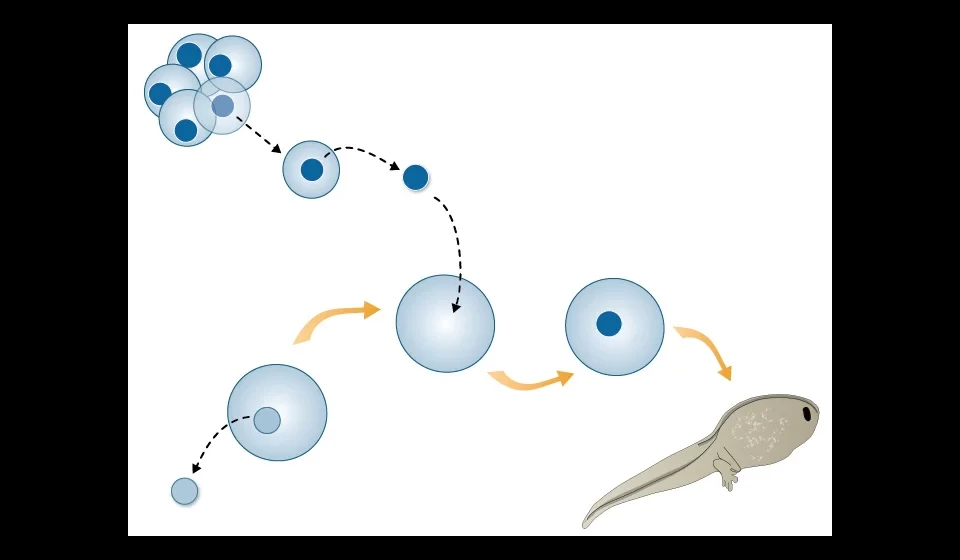The History of Cloning
June 01, 2023

Image ©https://learn.genetics.utah.edu/content/cloning/clonezone
Article by Mariam Mujiri
Source GZAAT STEM Journal
At the first glance, cloning might be something that we can only see in sci-fi movies. However, scientific developments have made that process fully possible and cloning nowadays has become a widely established practice. Cloning can be beneficial for various reasons, and today we are going to explain what exactly is the science behind it.
Cloning, by the definition of the Oxford Dictionary, is the process of producing an exact copy of an animal or a plant from its cells. Although artificial cloning is an invention of the 19th century, this process has existed for millions of years since it’s the primary asexual method of reproduction in single-celled organisms and even in some birds that we encounter on a daily basis, such as turkeys or condors, fish, and insects. Cloning has been done naturally in the past, but with scientific developments we are now able to artificially clone almost any being in the comfort of our labs.
The most common and practiced way of artificial cloning is the transfer of a cell's genetic information into an egg cell which will later develop into a separate organism if it has a host body, a surrogate mother.
Hans Adolf Eduard Driesch conducted the first cloning experiment on sea urchins in 1885.. This experiment was conducted by shaking the embryo of a sea urchin until its cells separated and each cell grew into a separate sea urchin. This experiment demonstrated not only that cloning is fully possible but also that each cell contained its own set of DNA and was capable of developing on its own.
Steen Wiladsen was the first person to make a clone of a mammal, a sheep. in 1984. At first he took an embryo of 8 sheep cells, separating them into single cells. After that he merged it to an enucleated egg, which means an egg cell that has had its nucleus removed, using electric shock, and planted the divided cells into a sheep surrogate who birthed three sheep.
However, the experiment conducted in 1996 by Ian Wilmut and Keith Campbell proved to be revolutionary. They cloned a sheep once again using cultured cells, which are cells that are artificially grown in labs, proving almost all cells, not only embryos, can be used for cloning. Dolly, the sheep that was born after the experiment, was the longest living clone. The use of cultured cells was important because fully developed cells lose some of their genetic material when used in experiments, and since cultured cells are artificially grown they are easier to manipulate.
Li Meng, John Ely, Richard Stouffer, and Don Wolf conducted another groundbreaking successful experiment in 1997 after cloning the first primate using previous methodologies, proving that primates, the closest relatives to the human species, can be cloned.
In 1997 Angelika Schnieke, Keith Campbell, Ian Wilmut were not the first to condone cloning for human profit, but they were definitely the first to actually bring ideas to a reality when they introduced a gene responsible for creating blood clots into a nucleus for a sheep clone, resulting in the sheep Polly which was able to produce the gene for blood clotting in her milk.
Endangered species were also cloned successfully in 2001, leading to maybe one of the most successful ways of preserving endangered species.
The latest, and arguably the most important clonation experiment was finally conducted in 2013 when human cells were cloned in the same way that all the previous experiments have been conducted using somatic cells, creating cells that could develop into a baby with the same genetic diseases as its clone. Minor technological changes led to success. The egg and body cells were fused together using an inactivated form of the Sendai virus (known to be prone to cell fusion), and embryo development was triggered by an electric shock. They added caffeine, which prevents the egg from being activated too early. While scientists had known for a long time that human cloning could be possible, it became a conflict of interest to create and bring to life actual clones, so Soukhrat Mitalipov and his colleagues had to stop in order to avoid ethical dilemmas.
As we can see, in today's reality we are at a point in life where cloning is fully possible and even widely practiced. Cloning has infinite uses and profits for everyone, such as harvesting the cells and resources that your clone makes for your own use, harvesting their organs for your own usage, making cloned animals produce different biological products which we are in need of, or maybe using clonation in order to revive or keep alive endangered or already extinguished species.
The real problem however comes with the morals and ethics of cloning. Cloning is done mostly for our own benefit and the ones at cost will be the clones. The ethics dilemma comes when thinking about clones as general beings which are as capable as we are of all things we can do. This is one of the taboos that holds back society from progressing further in the aspect of cloning in the scientific community.
Bibliography :
● The History of Cloning. learn.genetics.utah.edu/content/cloning/clonezone.
● Klus, Helen. “From Mammoths to People: A Brief History of Cloning.” The Star Garden, 6 Aug. 2017, www.thestargarden.co.uk/History-of-cloning.html.
● Cyranoski, David Nature Magazine. “Patient-Specific Human Embryonic Stem Cells Created by Cloning.” Scientific American, 15 May 2013, www.scientificamerican.com/article/patient-specific-human-embryonic-stem-cells-create d-cloning.

